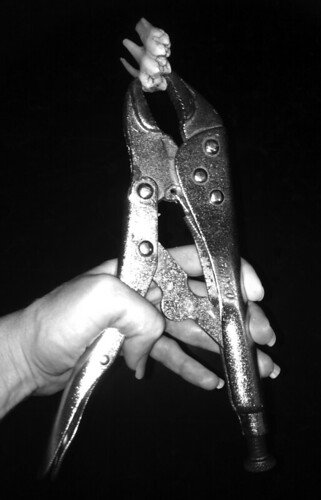Besides bones, I mostly use teeth in my jewelry and art.
The necklace seen in my banner above was made nearly 20 years ago from my own wisdom teeth. Yes, I sometimes use human teeth but they are a lot harder and more expensive to come by than most other animal teeth. I recently acquired a vial of 47 vintage human teeth. Sadly because of their poor condition most can not be used. But stay tuned for the rest in upcoming creations.
I usually get my animal teeth from partial skulls and broken jaws. Which sadly is often the case for most roadkill. Here is a selection of those before I cleaned them and removed the teeth. Animals range from elk and wild boar to dog... some human teeth pictured as well.
Now you don't want to just grab a pair of pliers and start pulling. That's a good way to chip the enamel, break off the roots or break the jaw (if it is one you wish to keep intact).
I dropped all of the partial skulls/jaws in a crock pot of water and slow cooked them for a couple days on the lowest setting. Topping off the water as it cooked off. If you don't have a crock pot you can still do it on the stove. But it works best in a crock pot because you want a constant low heat, not a rolling boil.
Otherwise it may cause the enamel to chip and teeth to break in half. Also take into consideration that if the skull/jaw has been outside for a long time, very old, very porous or buried a while it is going to be more brittle. Believe me, I found out the hard way about these things. This is a process not to be rushed!
Here is an Elk tooth that became very brittle after getting too hot for too long. I had found it buried out West in Colorado and no telling how long it had been there. Much of the roots broke off and the enamel is now chipping away.
After a couple days of crock pot cooking the bone should become soft and brittle. Most of those skulls/jaws pictured above were quite old, sun bleached and porous so they started to fall apart quite easily and I ended up with this:
After you're done cooking pour the bone/tooth stew through a strainer into your sink and rinse a bit to slightly cool the bones/teeth just enough so that you can handle them. Now while still warm quickly start working on getting the teeth out of any remaining bone with pliers. I found it easier to pull the teeth out and tear apart the bone while it was still warm and wet. You don't want the bones to cool completely or dry. The bone will tighten around the teeth again.
You know you have cooked long enough when the bone is soft enough to smash and break with pliers. Be careful when pulling the teeth, you can chip the enamel if you squeeze too tightly or break the roots if the bone is not soft enough. Don't forget there are really long roots on some teeth so you want to be careful where you crush into the bone.
Here is a much harder and newer wild boar jaw that was slow cooked for two days. You can see that it is much more solid than those bones above. When breaking apart bone like this you want to be careful not to cut your hands with sharp bones pieces. It is quite possible and nearly happened to me plenty of times before.
I carefully started by pulling some teeth at the front of the jaw out. Wiggling them and cutting away at the bone with pliers until they came out with ease. After a few teeth were removed the jaw split in half beautifully exposing the roots.
I worked up the jaw on both sides this way. The teeth in back just needed a secure tug with pliers and they came out once enough bone was removed. Once you have your teeth out give them a good rinse and lay them out of a towel to dry. If you want them whiter drop them in a hydrogen peroxide and water bath until they are the color you like.
I also have extensive experience in tooth extraction because of a previous photo project I started in 2008 - "Nothing But Teeth."
This photo series started as a project for a band's album artwork and continues because of my love for teeth.
You can see my whole "Nothing But Teeth" Photo Set HERE.
---
Saturday, August 27, 2011
Subscribe to:
Post Comments (Atom)
















5 comments:
Hello!
I've been looking at your blog for a little while now- good stuff! :D
What do you think is the best way to smooth out chipped roots? Dremel? Sandpaper?
Thanks Mid! I would suggest a Dremel and practicing cutting/sawing/sanding bones and teeth to get a feel of what tools work best for you. IMPORTANT - Wear a respirator if you are making bone dust fly, it is very bad for you to breathe in! Good luck... jana
We recently lost or wolf hybrid and my son would like to save a tooth from him for a necklace. Any suggestions on removing one or two
First off, I'm sorry for your loss Lawrence. I do pet memorial processing and have had similar request before. You would need to have your vet surgically remove it or you need to process the skull and remove it yourself.
This was really helpful...thank you!
Post a Comment